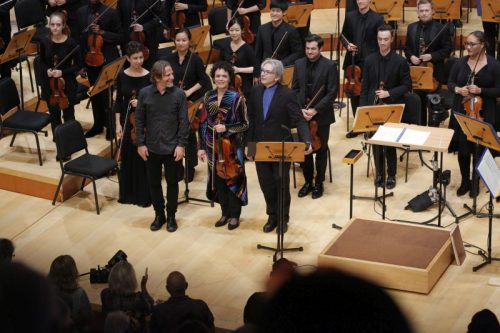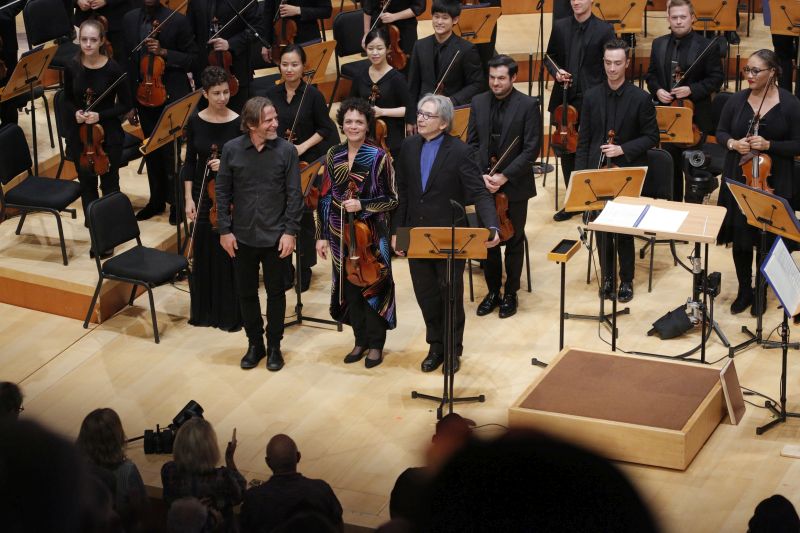 United States Higdon, Feldman, Berlioz arr. Steven Mackey: Roberto Diaz, Tabea Zimmermann, and Cynthia Phelps (violas), New World Symphony / Michael Tilson Thomas and Christopher Rountree (conductors). New World Center, Miami. 19.10.2019. (LV)
United States Higdon, Feldman, Berlioz arr. Steven Mackey: Roberto Diaz, Tabea Zimmermann, and Cynthia Phelps (violas), New World Symphony / Michael Tilson Thomas and Christopher Rountree (conductors). New World Center, Miami. 19.10.2019. (LV)

and the New World Symphony
Higdon – Viola Concerto (2014)
Feldman – The Viola in My Life 4 (1971)
Berlioz/Steven Mackey – Harold in Italy (1834/2019, world premiere of NWS commission)
In the last of the three ‘Viola Visions’ Festival concerts — celebrating the intersection of the viola and the 21st century — the New World Symphony ended with a back-to-the-future leap into the unknown, which showed that Berlioz knew what he was doing when he stopped listening to Paganini, if he ever did at all.
In fact, Schumann, who was one of Berlioz’s early champions, is said to have observed that whenever Berlioz makes what seems a mistake, every attempt to correct it is fated to substitute something that is both characteristic — and impossibly banal. Despite the truth of Schumann’s premonition, it is a fascinating speculation, like the unprovable Goldbach Conjecture in mathematics.
And so it was an heroic response when Michael Tilson Thomas, who had long ‘harbored the wish that the collaboration between Berlioz and Paganini might have really worked’ (and by chance had his own viola festival) decided that Steven Mackey was the man to have a go at it. ‘The violist’, he said, ‘needs to step out and say, “En garde!”‘
Tilson Thomas is likely fully aware that the full phrase is ‘En garde! Prêts? Allez!’. Clad in self-effacing black, with violist Tabea Zimmermann in a Technicolor swirl at his side, the conductor swept his charges without ceremony into a young, fluent and virtuosic Harold in Italy that was all about Berlioz and his love for sound and color.
That is, until the end of the third movement, when Mackey began working the magic of his art with a short, entirely new interlude connecting the third and fourth movements. With lots of additional virtuoso passages in the last movement intended, the composer told me he wanted ‘to really mix it up with the brigands’.
After the sunrise opening, Zimmermann showed — with the first single stroke of her bow — how Berlioz had fallen in love about the viola. Its deep reservoirs of color, its sex appeal, the thrill of hearing it in fast passagework and especially, harking back perhaps to viola d’amores and even gambas, in arpeggio — hallucinogenically sul ponticello if possible. And beyond all that, Zimmermann found seemingly infinite dimensions to express her own feelings about beauty and phrasing, what Berlioz meant by ‘soul.’
After a refreshing, quick ‘Abruzzi Serenade’ with a superb oboe came Mackey’s first addition, a cadenza adorned with some of the most moving phrases and gestures recalled from the first three movements, echoed by the English horn and bassoon. The new material ends in a floral dance that bursts into a wonderfully wild ‘Orgy of Brigands.’
Order is restored at first, but when the viola unexpectedly enters into a contentious dialogue with the orchestra, conventional cadential trills lead to bursts of new virtuosic passagework that elaborate on Berlioz’s wild narrative without disrupting the tunes — but definitely creating chaos. As tensions increase, a solo cello in the upper reaches of the hall signals the end may be near. For the last minute — after all that it has done — the violist stands silent.
The evening opened with Jennifer Higdon’s Viola Concerto from 2014, in a splendid reading by its dedicatee, Roberto Díaz. Higdon’s vivid instrumentation (pairs of clarinets, flutes, trumpets, and trombones, with bassoon and contrabassoon, plus several enchanting members of the mallet percussion family) created a dynamic backdrop for both the somber beauty of Díaz’s instrument (the ex-Primrose Amati) and high notes so pure and thrilling that it was like hearing Primrose himself. From the start, Higdon’s concerto engaged the audience’s affections — poignantly so towards the end, in gorgeous solos with the principal cello and concertmaster.
So often, there is so little to be said by Morton Feldman — and so long to hear it — that eventually the deeply philosophical man behind the notes begins to emerge as a presence. Tilson Thomas, who recalled the composer ‘as one of the wittiest, most sparkling people I knew’, compared the ‘beauteous loneliness’ of The Viola in My Life 4 to one of the abstract paintings the composer was so closely associated with, and examining its ‘squiggles and colors’ — slowly.
Playing barefoot, violist Cynthia Phelps moved silently among three onstage stations. Her silky command of Feldman’s infinitely subtle gradations floated sound and silence into the air, while the conductor found jazz in the brass chords presaging the end. Feldman’s ‘classical music for Spock’ ended as the lights, which had projected visual images on the walls, faded to black.
At the time of publication, Tilson Thomas and his team had not yet announced the instrument to be celebrated in 2020. My choice: a recreation of Gerard Hoffnung’s Astronautical Music Festival of 1961, celebrating both the tuba and the great British tubist and humorist, capped off by the conductor’s first-ever performance of Beethoven’s Leonore Overture No.4.
Laurence Vittes
